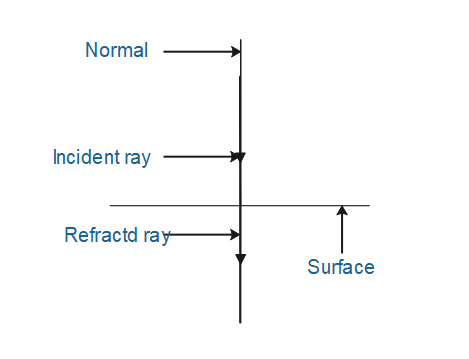
During normal incidence of light:
A. Angle of incidence is ${{90}^{\circ }}$
B. Angle of incidence is ${{0}^{\circ }}$
C. Sum of angle of incidence and angle of reflection is ${{90}^{\circ }}$
D. Angle of incidence is greater than angle of reflection.
Answer
445.2k+ views
Hint: When a ray incident on obstacle or surface or medium, it makes an angle with normal direction of normal ray or normal is always perpendicular to surface i.e. angle is ${{90}^{\circ }}$ and angle of normal with itself is zero. When ray incident along a normal ray it makes ${{90}^{\circ }}$ angle with a surface of ${{0}^{\circ }}$ angle with itself.
Complete step by step answer:

When a ray of light is incident on a surface or any medium from source, it makes some angle with the surface, with normal as well as with refracted ray. Angle between incident ray and normal is known for angle of incidence whereas angle between refracted ray which gets refracted because of surface and normal is known for refracted ray.
Normal is ray when always staying perpendicular to the surface and angle between them is always ${{90}^{\circ }}$ . whereas angle between normal with itself is zero.
Now, if incident ray incidents normally to the surface i.e. along normal ray then it makes zero angle with normal and this is known as normal incidence of light on the point of incident.
If incident ray makes any other angle other than zero degree then angle of incidence is known as oblique angle.
Therefore, option (B) is the correct option.
Additional information:
When a ray of light is incident on the interface of two mediums, part of light is reflected back into the same medium and this phenomenon is known as partial reflection. Whatever be the remaining part, light gets transmitted in the second medium. This is known as refraction of light. These two laws are applicable & obeys at the interface only.
The incident ray and refracted ray are always on the opposite sides of the normal or interface at the point of interface. All three lie in the same plane.
Note: The angle made by incident ray with refracting surface or interface or medium is known as glancing angle as shown in figure. If the angle of incidence is incident along the surface or interface then the angle between incident ray & normal is ${{90}^{\circ }}$ . In this case option (A) will be correct. If angle of incidence and angle of reflection is the same then sum of angle of incidence and angle of reflection is ${{90}^{\circ }}$. When incident ray passes from a rarer medium to a denser medium, it bends towards the normal, in this case angle of incidence is greater than the reflection then option (D) will be the correct option.
Complete step by step answer:

When a ray of light is incident on a surface or any medium from source, it makes some angle with the surface, with normal as well as with refracted ray. Angle between incident ray and normal is known for angle of incidence whereas angle between refracted ray which gets refracted because of surface and normal is known for refracted ray.
Normal is ray when always staying perpendicular to the surface and angle between them is always ${{90}^{\circ }}$ . whereas angle between normal with itself is zero.
Now, if incident ray incidents normally to the surface i.e. along normal ray then it makes zero angle with normal and this is known as normal incidence of light on the point of incident.
If incident ray makes any other angle other than zero degree then angle of incidence is known as oblique angle.
Therefore, option (B) is the correct option.
Additional information:
When a ray of light is incident on the interface of two mediums, part of light is reflected back into the same medium and this phenomenon is known as partial reflection. Whatever be the remaining part, light gets transmitted in the second medium. This is known as refraction of light. These two laws are applicable & obeys at the interface only.
The incident ray and refracted ray are always on the opposite sides of the normal or interface at the point of interface. All three lie in the same plane.
Note: The angle made by incident ray with refracting surface or interface or medium is known as glancing angle as shown in figure. If the angle of incidence is incident along the surface or interface then the angle between incident ray & normal is ${{90}^{\circ }}$ . In this case option (A) will be correct. If angle of incidence and angle of reflection is the same then sum of angle of incidence and angle of reflection is ${{90}^{\circ }}$. When incident ray passes from a rarer medium to a denser medium, it bends towards the normal, in this case angle of incidence is greater than the reflection then option (D) will be the correct option.
Recently Updated Pages
Master Class 11 Accountancy: Engaging Questions & Answers for Success

Express the following as a fraction and simplify a class 7 maths CBSE

The length and width of a rectangle are in ratio of class 7 maths CBSE

The ratio of the income to the expenditure of a family class 7 maths CBSE

How do you write 025 million in scientific notatio class 7 maths CBSE

How do you convert 295 meters per second to kilometers class 7 maths CBSE

Trending doubts
One Metric ton is equal to kg A 10000 B 1000 C 100 class 11 physics CBSE

Write down 5 differences between Ntype and Ptype s class 11 physics CBSE

Soap bubble appears coloured due to the phenomenon class 11 physics CBSE

Proton was discovered by A Thomson B Rutherford C Chadwick class 11 chemistry CBSE

How is the brain protected from injury and shock class 11 biology CBSE

Define least count of vernier callipers How do you class 11 physics CBSE




